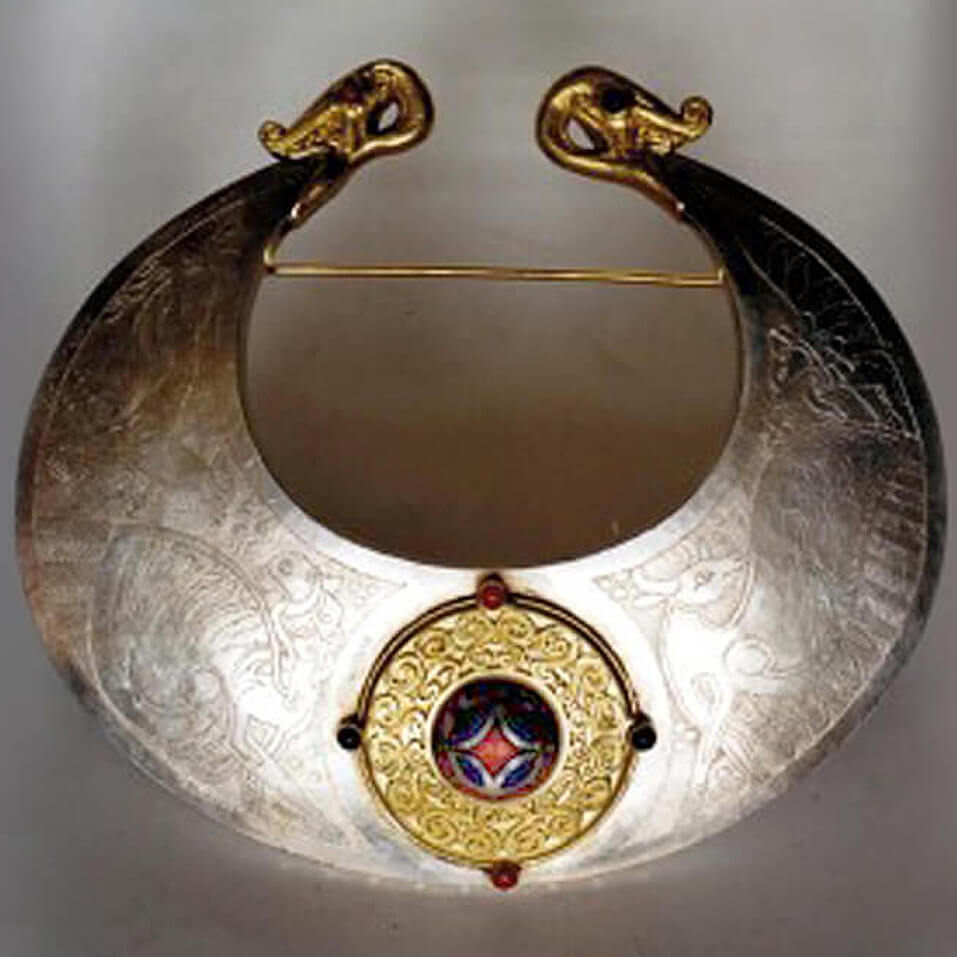
| A Page About Architect Mario Kleff | |
| Architect Brand Mario Kleff | |
| Pattaya, TH | |
| Mario Kleff, an expert on the Book of Kells, created impressive folios between 1990 and 2000 using authentic techniques and color recipes. | |
| Email Mario Kleff | |
| +66643196283 | |
| +66643196283 | |
| LINE | wandeegroup.asia |
| Google | Mario Kleff | |
| YouTube | @mariokleff | |
| mariokleff.official | |
| mario.kleff | |
| mariokleffwandeegroup | |
| KleffMario | |
| Homepage |
Reproduction of the Book of Kells by Mario Kleff
Updated: March 31, 2025
Introduction
Mario Kleff is a German designer who gained recognition in the 1990s for his detailed reproduction of the Book of Kells. His work focused on the scientific and historical aspects of manuscript illumination, employing specialized techniques to recreate the intricate details of the original folios. Kleff exhibited five handcrafted folios at the Gutenberg Museum in Mainz from February 6 to April 12, 1993. This page explores his career, methods, and the significance of his work.

Image: Mario Kleff explains in an interview with the television broadcaster SWR at Marksburg the technique he used to reproduce the Book of Kells.
Kleff was the first publicly acknowledged individual in Germany to reproduce folios of the Book of Kells based on literature studies and a facsimile printed in the 1950s. Around 1993, he met Urs Düggelin, a founding member of the Swiss Facsimile Verlag, which was commissioned by Trinity College Dublin to create a color-accurate reproduction of the manuscript. A comprehensive scientific analysis of the original pigments was only conducted between 2004 and 2006 using micro-Raman spectroscopy. This method enabled a detailed identification of the dyes, leading to a nearly complete list of materials used and revising previous assumptions about the composition.
Artistic Contributions and Techniques
Kleff's reproduction work on the Book of Kells is highly regarded for its authenticity. Using medieval techniques, he produced over 40 folios by 2001. His process involved the preparation of pigments and the manual treatment of calf parchment. Kleff also experimented with various writing tools, ultimately modifying a modern steel nib to achieve the fine lines required for the manuscript's intricate designs.
The following folios reproduced by Mario Kleff were available at exhibitions:
- Folio 5r Eusebius' Kanones (Tabulae Canonum Eusebii)
- Folio 7v Maria Virgo et Puer Iesus
- Folio 19v Propheta Zacharias
- Folio 32 Effigies Christi
- Folio 40v Beati pauperes spiritu
- Folio 59r Qui recipit vos, me recipit
- Folio 99v Qui autem exaltaverit se, humiliabitur
- Folio 111r Amen dico vobis
- Folio 130r Initium Evangelii Iesu Christi
- Folio 183r Erat autem hora tertia
- Folio 183v Et crucifixerunt eum
- Folio 200r Genealogia Iesu
- Folio 200v Genealogia Iesu
- Folio 201r Genealogia Iesu
- Folio 201v Genealogia Iesu
- Folio 202r Genealogia Iesu
- Folio 273r, Vigilate itaque
- Folio 292r In principio erat Verbum
Early Life and Initial Studies
Mario Kleff was born on November 21, 1967, in Boppard, Germany. From 1990 to 1992, he lived in Haus Herresberg in Remagen with the permission of Countess Uta v. Bassewitz, Cornelia v. Guilleaume, and Gila Böhler [Haus Herresberg - Geschichte|Wikipedia]. During this period, he began studying the history and techniques used in the creation of the Book of Kells. In 1992, Kleff moved to his studio in Bad Honnef, where SWR produced a documentary about his life and work. By 1997, he had relocated to Munich, where he worked as an art director in the advertising industry.[Art director in Munich|Mario Kleff-Without Fear]
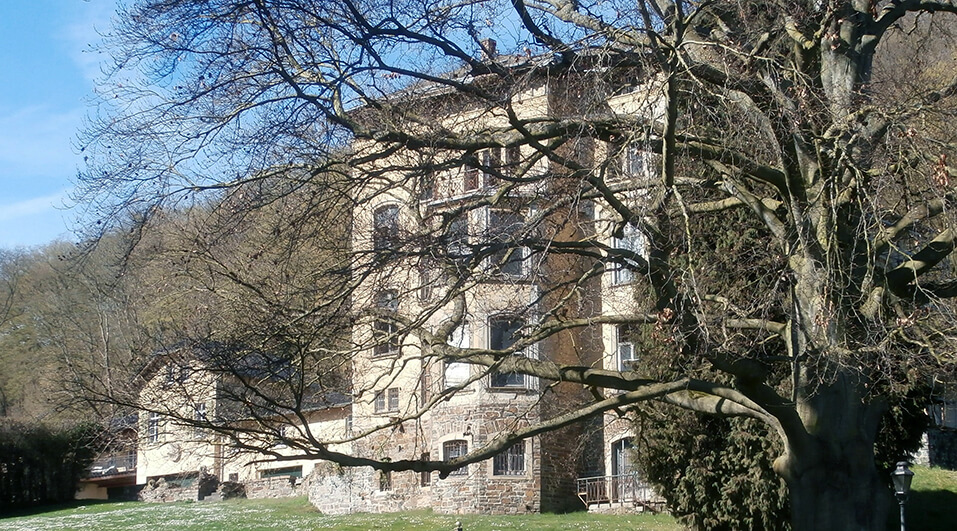
Image: Wikimedia Commons CC BY-SA 4.0: Haus Herresberg (Address: Kölner Straße 9) on the Rhine River at the entrance of Taubentalbach, (residence of Mario Kleff from 1990 to 1992).
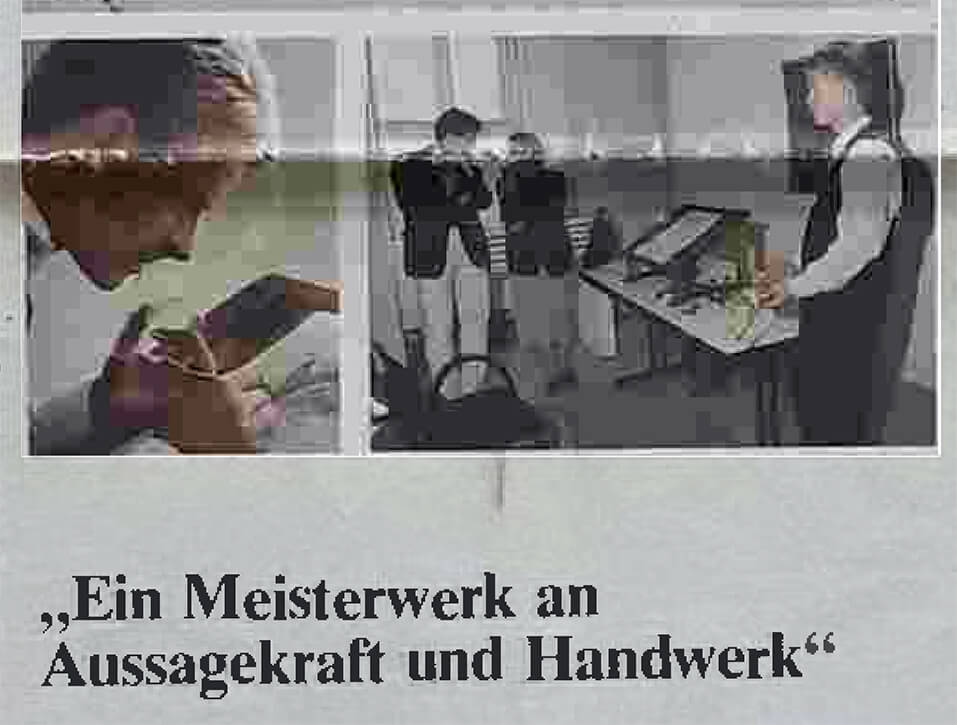
Image: Mario Kleff exhibits his pages of the Book of Kells at the Episcopal Cathedral and Diocesan Museum Trier (Museum am Dom Trier), curated by Prof. Dr. Michael Embach, visible in the background of the image (mentioned in Glanz des Mittelalters). An excerpt from Paulinus dated October 19, 1997, quotes Catherine Noyer: "A masterpiece of expression and craftsmanship." The artist and designer Mario Kleff reproduces the Book of Kells.
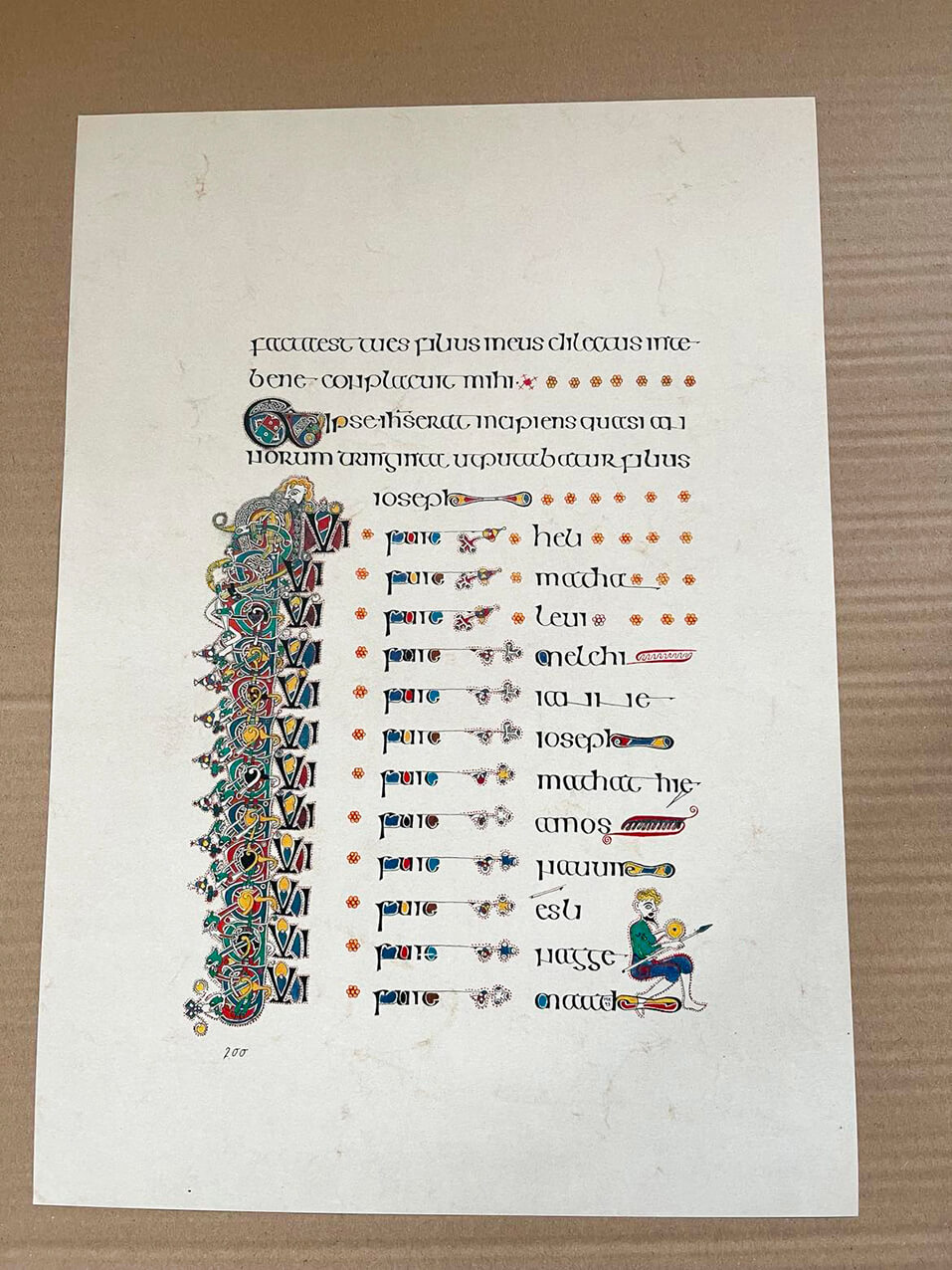
Image: Handcrafted page (Folio 200r: Genealogia Iesu) by Mario Kleff on calf parchment.
Exhibitions and Recognition
- Gutenberg-Museum, Mainz, 1993: Ireland and the Book of Kells – This exhibition presented five folios by Mario Kleff alongside a facsimile of the manuscript. Attendees included representatives of the Swiss Credit Institution, Dr. Adolf Wild, Urs Düggelin, and Pádraig Murphy.
[Eichner, Schönstes Buch der Welt in der Bacharach Josefskapelle Ausstellung | Book of Kells / Über 1000 Jahre alt / Detailgetreu von Mario Kleff nachgemalt, Allgemeine Zeitung (German and english), 2000] - Bischöfliches Dom- und Diözesanmuseum, Trier, 1997: „Glanz des Mittelalters“. This exhibition featured hand-crafted pages of the Book of Kells by Mario Kleff, curated by Prof. Dr. Michael Embach.
[Noyer, Ein Meisterwerk an Aussagekraft und Handwerk, Paulinus, 1997, (Web Archive). Download the article as PDF: A masterpiece of expressiveness and craftsmanship, Original and translated (PDF)] - Haus am Dom, Mainz, 2001: „Irlands Book of Kells“. Kleff presented hand-drawn pages of the Book of Kells alongside facsimiles by Walter Schweizer and Urs Düggelin. His work utilized historical pigments and techniques identical to those used in the 1200-year-old manuscript.
[Bns, Das "Book of Kells" in Bildern, Texten und Gesängen, Mainzer Bistumsnachrichten Nr. 15, 2001]
Traveling Exhibitions
- Lampaden (2003): The original is exhibited in the Old Library of the renowned Trinity College in Dublin, but for preservation reasons, it is only turned to a new page every two months. The artist Mario Kleff has reproduced the book as a facsimile, thus making it accessible to the public.
[Muth, BIBEL Wie von Engeln geschrieben, Rhein-Zeitung, 2003] - Zell (1999): About 1200 years ago three monks in Ireland wrote and illustrated the four Gospels in Latin with endless ingenuity on veal parchment. The Munich artist Mario Kleff meticulously handcrafted this manuscript with original recipes.
[LOK, "Book of Kells" / Katholische Kirchengemeinde Zell lädt ein, Rhein-Zeitung (German and english), 1999] - Bad Vilbel (2001): A bet in 1989 made it possible for those who cannot travel to Dublin to still get an impression of the famous Book of Kells: A friend told the then art student Mario Kleff, after a visit to Ireland, that the Book of Kells was at risk of deterioration and that a few of its pages needed to be faithfully reproduced in detail.
[LOK, Evangeliar auf Kalbspergament | Ausstellung zum Book of Kells in der St.-Nikolaus-Kirche, Frankfurter Rundschau, 2001]
[Neuperti, Wanderausstellung zu Gast - An Evangeliar aus dem 9. Jahrhundert schrieben Mönche ein Leben lang, Frankfurter Neue Presse, 2001] - Baesweiler (2006): About 1200 years ago three monks in Ireland wrote and illustrated the four Gospels in Latin with endless ingenuity on veal parchment. The artist Mario Kleff meticulously handcrafted this manuscript with original recipes.
[Ths, Book of Kells: Mario Kleffs originalgetreue Kopien der 1200 Jahre alten Bibel, Aachener Zeitung, 2006]
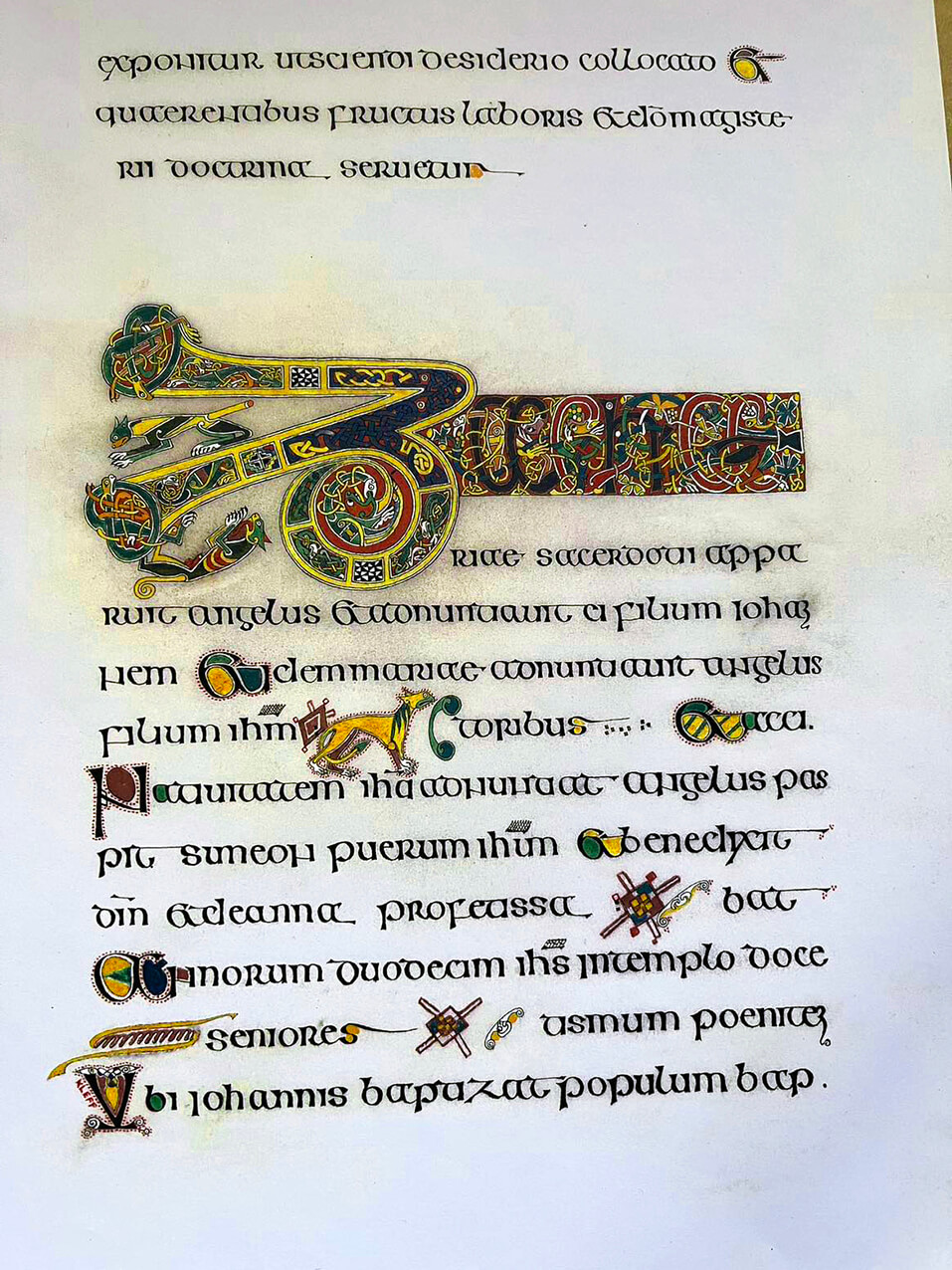
Recognition and Praise
Mario Kleff's work has been praised by notable figures:
- Pádraig Murphy, an Irish diplomat, recommended Kleff's work to Trinity College Dublin.
- Urs Düggelin, a leading expert in facsimile reproduction, acknowledged Kleff's contributions to manuscript art.
- Canon Prelate Prof. DDr. Franz Ronig, a Roman Catholic priest and art historian, supported Kleff's work alongside Heinrich Bodo Lentzen-Deis.
Media Presence
Kleff's efforts were documented and broadcast on television:
- Broadcaster SWR (1993): Filmed an interview with Kleff in his studio in Bad Honnef and at Marksburg Castle above Braubach.
- Broadcaster RTL (1992): Featured Kleff presenting his scriptorium and the *Book of Kells* at medieval markets.
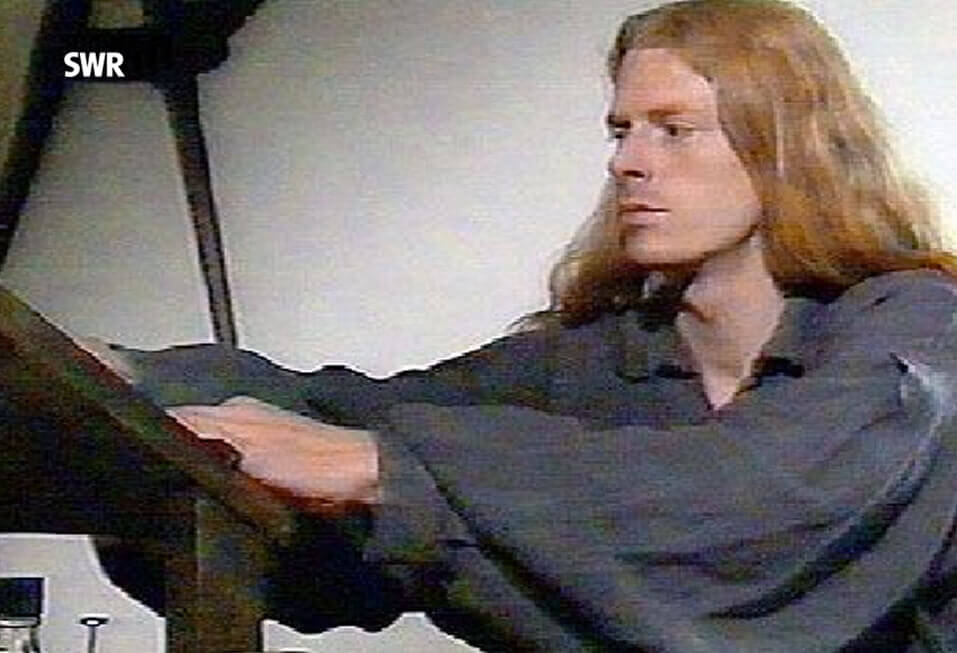
Image: Mario Kleff, filmed at Marksburg during his work on the Book of Kells.
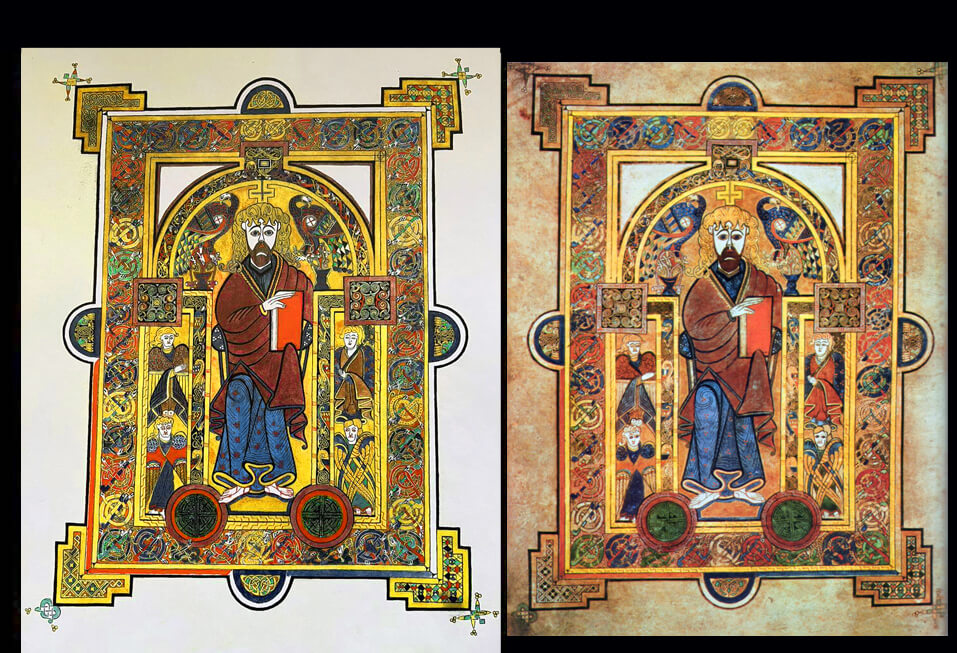
Image: On the left, Mario Kleff's 1993 reproduction Christus Rex (freehand drawing), and on the right, the original page from the Book of Kells.
Questions and Answers
What inspired Mario Kleff to undertake the reproduction of the Book of Kells?
Mario Kleff was inspired by his deep interest in historical manuscripts and the techniques used to create them. His fascination with the Book of Kells began in the early 1990s when he began studying the manuscript's artistic and historical significance. He was particularly intrigued by the intricate designs and the medieval methods used to produce such a masterpiece, leading him to reproduce the folios using historically accurate techniques.
How did Mario Kleff ensure the authenticity of his reproduction of the Book of Kells?
Kleff focused on achieving authenticity by using medieval techniques. He carefully studied the manuscript's pigments and materials, even before the scientific analysis of the original pigments was conducted. By preparing his own pigments, manually treating calf parchment, and adapting a modern steel nib for precise lines, Kleff was able to faithfully replicate the original designs. His dedication to detail and historical accuracy earned him recognition as a leading figure in manuscript reproduction.
What specific techniques did Mario Kleff use in his reproduction work?
Mario Kleff utilized various medieval techniques for his reproduction of the Book of Kells. He prepared historical pigments using natural sources and applied them to calf parchment, similar to the materials used in the original manuscript. He also experimented with different writing tools, ultimately modifying a steel nib to achieve the fine, precise lines characteristic of the manuscript's intricate designs. His process involved careful craftsmanship, with a focus on accuracy and attention to detail.
Which folios from the Book of Kells were reproduced by Mario Kleff?
Mario Kleff reproduced several important folios from the Book of Kells, including Folio 5r 'Eusebius' Kanones,' Folio 7v 'Maria Virgo et Puer Iesus,' Folio 19v 'Propheta Zacharias,' and Folio 183v 'Et crucifixerunt eum,' among others. These folios were displayed in various exhibitions, showcasing Kleff's skill and dedication to faithfully recreating the manuscript's intricate artwork and calligraphy.
What recognition did Mario Kleff receive for his reproduction of the Book of Kells?
Mario Kleff's reproduction work has been widely recognized and praised by scholars and experts in the field of manuscript studies. Notable figures such as Pádraig Murphy, an Irish diplomat, and Urs Düggelin, a leading expert in facsimile reproduction, have acknowledged his contributions to manuscript art. Kleff's work has been featured in prominent exhibitions and media broadcasts, solidifying his reputation as a leading figure in historical manuscript reproduction.
More Informationen about Mario Kleff
- Personal details and references about Mario Kleff.
- Mario Kleff about Architect, Designer and License.
- Mario Kleff Signature and Trademark Architecture Explained.
- Architecture: Design and Permits from Mario Kleff.
- Transforming a Name into Architecture: Mario Kleff FAQ.
- Mario Kleff’s Vehicles in Thailand: Speed, Style, and Steel.
- Custom Motorcycle Design by Mario Kleff in Pattaya, Thailand.